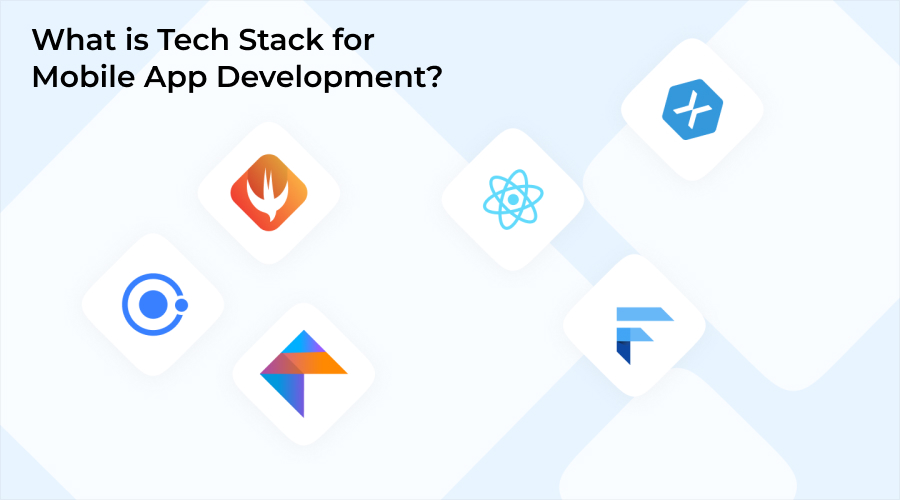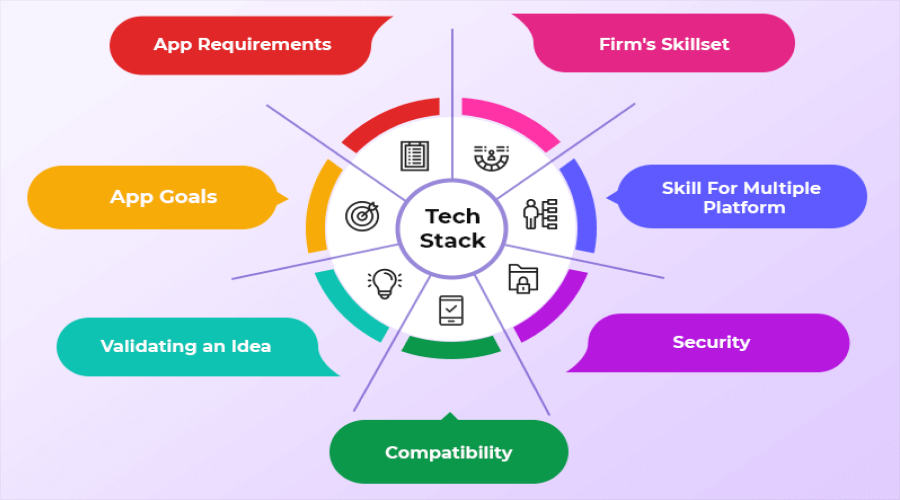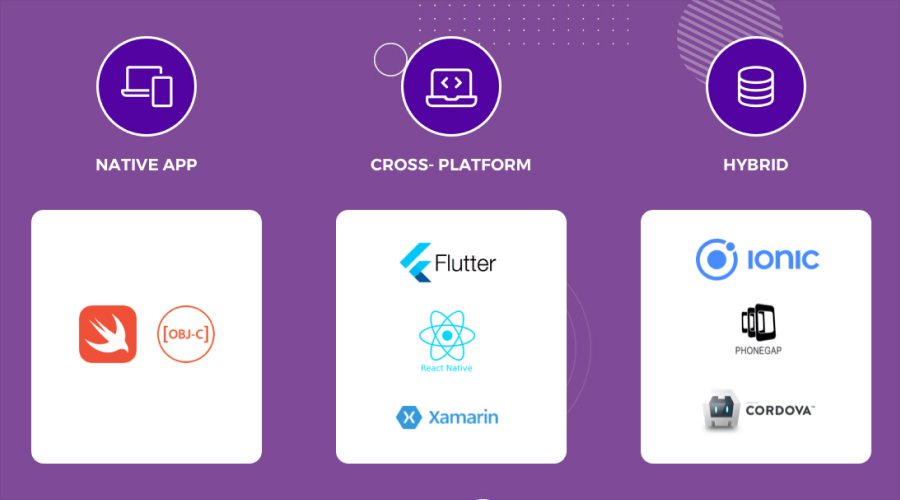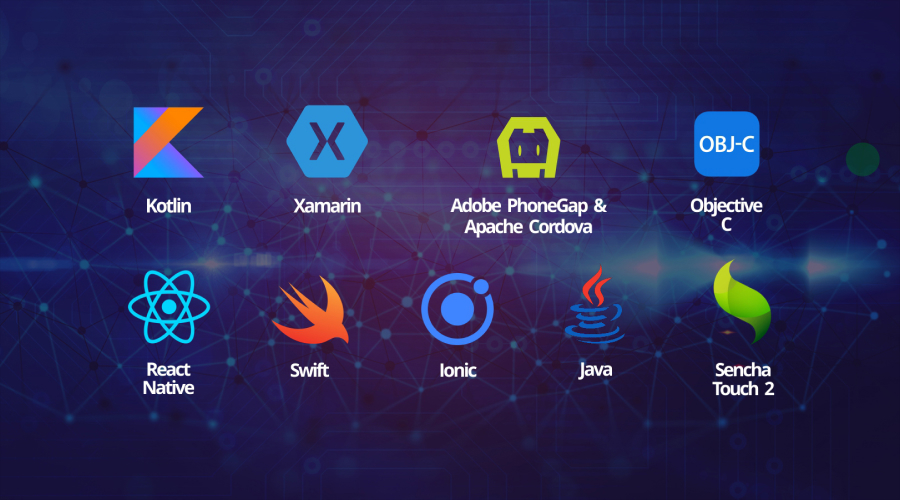
Mobile applications have become vital for modern-age users. Modern users rely heavily on mobile applications for day-to-day tasks. In such a scenario, it becomes crucial for business owners to invest in mobile app development. However, building a mobile app begins with the wisest selection of technology stack. Yes, selecting the right tech stack is a crucial step in the mobile app development journey. Doing so ensures a seamless user experience for your clients, which ultimately translates to improved ROI and profit margins. If you are wondering how to choose the right tech stack for mobile app, then read this post. This post covers everything that you need to know about the right tech stack, including the steps needed for choosing the right one. Let’s dive in…
Table of Content
- What is Tech Stack for Mobile App Development?
- Why Is Choosing Tech Stack For Mobile App Development Important?
- Things To Consider When Choosing Mobile App Tech Stack For Your Project
- Types Of Tech Stacks For Mobile App Development
- Best Tech Stack You Can Use For Mobile App Development
- Conclusion
What is Tech Stack for Mobile App Development?

A tech stack is nothing but the collection of tools and technologies used for creating or developing a mobile application. It includes frameworks, programming languages, and UX/UI design tools. Aside from that, the right tech stack also includes hosting, mobile app platforms, cloud-based resources, testing tools, and database management systems. A comprehensive right tech stack offers numerous benefits for mobile app development projects. That is why it is crucial to select an appropriate the right tech stack. Doing so ensures the outcome is worthwhile. Application built using the right tech stack provides a smooth user experience for your clients and helps achieve your business goals.
Why Is Choosing Right Tech Stack For Mobile App Development Important?

Selecting the appropriate tech stack is crucial for successful mobile app development. The right choice of tech stack can significantly influence the success of your project. The abrupt selection of a tech stack, or one chosen without careful consideration, can result in project failure. Choosing the right mobile app development tools and technologies can significantly enhance user experience, leading to improved bottom lines. Moreover, it also aids in optimizing development processes and streamlining processes. Most advanced frameworks come with ready-to-use templates and components. You can consider using these frameworks to save significant time that you can invest in the core features of your app.
Things To Consider When Choosing Mobile App Tech Stack For Your Project
Guaranteeing a unique mobile app development is only possible if you choose the right tech stack. It can significantly influence the overall development process. There are several factors that you need to consider when selecting a Right tech stack for mobile app. Some of the most important factors are outlined here; take a look…
1. App Type
First things first, determine the app type before you select an appropriate tech stack for the mobile app. For instance, choose whether you need a native app or a cross-platform app. Depending on that you would be able to decide on the right tools and technology.
2. Complexity
Another factor to consider is the complexity of your app. Determining what features you plan to incorporate into your app is crucial as they are going to impact the choice of technologies.
3. Scalability
Of course, scalability is yet another important factor to consider. Ask yourself:
- What kind of app you are planning to build: a basic one or a fully-featured app?
- What are your long-term goals?
- How would you like your app to handle future growth?
- How about an increased user base in the future?
Once you know the answers to these questions, choosing the right tech stack will be easier. Make sure to give enough thought to these questions!
4. Target Platforms
The choice of platform is yet another important factor to consider when making the right choice of technology. Decide whether you wish to create an app for iOS or Android. Or are you planning to create a cross-platform app? Once you know this, choosing the right tools and technologies becomes a breeze.
5. Team Skills & Expertise
Team skill and expertise will also influence the choice of technology. Hence, it is crucial to consider the skills and experience of your development team prior to choosing the Right tech stack. It is advisable to choose technologies that your team members are comfortable and well-versed with.
6. Performance
Make sure to choose tools that offer good performance and optimize for mobile devices. The features that you plan to add to your app will heavily influence your choice of technology. For instance, highly advanced features, such as AR, VR, etc, will require Native technologies, like Swift and Kotlin. These frameworks will help you enhance product’s performance. On the other hand, for standard features, such as user interfaces, data management, etc, cross-platform tools like Flutter will do the best.
7. Security Features
Offering safe and secure application is a MUST. Hence, it should be your priority to develop an app that your customers can use fearlessly. For that, consider choosing choose tools and technologies that offer robust security features.
8. Community and Support
Don’t make a choice of technologies in haste at all. This can lead to severe outcomes later. It is always advisable to choose technologies that boast active communities and support group. Technologies that offer strong support options can be quite beneficial when assistance is required.
9. Estimated Time-to-Market
The estimated time to release your product to the end-user also affects the choice of technologies. Choose tools that facilitate quicker development and deployment if you aim to deliver the product promptly.
10. Budget
Last but not least is your budget. Evaluate the cost of development, maintenance, and licensing for different technologies prior to choosing the Right tech stack. Know that the budget varies significantly based on the app type and technology stacks you choose. For instance, if you choose to develop Native apps, then you will need to have separate development teams and codes for iOS and Android. This will ultimately add to the overall cost of the development. While with Cross-platform frameworks, you would be able to save a significant amount as Cross-platform apps are built on the same code.
Let’s now take a look at the different types of the Right tech stacks available for mobile app development. Here we go…
Types Of Right Tech Stacks For Mobile App Development

Tech stacks are primarily divided into three categories, namely, Native App Development, Cross-Platform App Development, and Hybrid App Development. Each of these approaches comes with its own pros and cons. Let’s now understand each approach in detail. Here we go…
1. Native Mobile App Development
Native apps, as the name says, are the ones that are developed using frameworks and languages specific to a particular platform. For instance, an app developed for iOS devices will be created using Swift for programming, Cocoa Touch framework for UI development, Xcode as the IDE, Objective-C (legacy), and optional tools like Core Data, Realm for databases, Firebase for backend, and APIs for integrations. While for a native Android app, you may require Kotlin or Java for programming, Android Studio (IDE), the Android SDK (Software Development Kit), additional tools like Jetpack Compose or XML Layout Editor, and potentially backend technologies like Firebase or Node.js with Express.
Pros:
- Native apps are dedicated apps.
- They are designed to provide optimal performance.
- These apps offer the best user experience as they are built specifically for the target platform.
- These apps can have access to platform-specific features.
- They are comparatively faster and more responsive.
- They easily integrate with device hardware, such as the GPS, camera, and so on.
Cons:
- Costly affairs as these apps are designed for specific platforms.
- Developing apps for different operating systems requires separate codebases and development teams.
- Time-consuming endeavors as you need to put in double effort.
- Require platform-specific expertise.
2. Cross-Platform Mobile App Development
Cross-platform apps are the ones that are developed using a single codebase and are deployed on multiple platforms, including iOS and Android. Some of the most popular cross-platform languages and frameworks are Flutter, React Native, Kotlin Multiplatform, Ionic, Xamarin/.NET MAUI, and Native Script.
Pros:
- Cross-platform mobile app developments are budget-friendly projects.
- Cross-platform mobile app development saves a lot of time as they are created using a single codebase for multiple platforms.
- Use of single codebases allow developers to develop and deploy apps faster.
- Made to attract a wider audience.
- Offers consistent user experience.
Cons:
- Performance glitches because at times these apps fail to perform like native apps.
- Inclusion of complex features or graphics hinder the performance.
- Limited access to platform-specific features.
- Achieving a truly native user experience is a challenge.
- Inconsistencies across platforms and devices.
3. Hybrid Mobile App Development
Hybrid mobile apps are the ones that are created using elements of both native and web apps. These apps are build using web technologies, like HTML, CSS, JavaScript and are packaged as native apps. This allows them to run on multiple platforms with a single codebase. Some of the most popular frameworks used for developing hybrid apps include Iconic, React Native, Flutter, Cordova/PhoneGap and so on.
Pros:
- Hybrid app development offers cross-platform compatibility.
- It uses shared codebases which leads to quicker time-to-market.
- Streamlined processes for development and testing save a lot of time.
- Easy to maintain, scale, and update.
- Offer unified user experience across platforms.
- These apps are developed using reusable codes that can be reused across multiple platforms.
- Development processes are streamlined, leading to quicker time-to-market.
Cons:
- Performance limitations, especially with complex features or graphics.
- Inconsistent user experience across platforms.
- Customizing the UI/UX for specific platforms can be challenging.
- Limited access to platform-specific features and functionalities.
Also Read: Difference between Native & Hybrid App Development
So, which is the best tack stack for mobile app development. Read ahead to know…
Best Tech Stack You Can Use For Mobile App Development

The choice of tech stack differs significantly depending on your business goals, the type of app you plan to create, the platform for which you plan to develop the app, target audience and the complexities involved. Tools and technologies for each app development vary based on their requirements and types. Here are some popular tech stack options you can consider selecting for mobile app development,
1. Native Apps Tech Stack
Know that the native app tech stack for mobile app and iOS devices will be absolutely different from the ones used for Android systems. You will require a separate development team, codes, and technologies for each platform to develop platform specific app.
For iOS Devices
- iOS SDK: iOS SDK (Software Development Kit) includes a suite of tools and technologies required for developing apps for Apple devices. Also, it includes UIKit, which is used for building user-friendly interfaces to help users have an enhanced experience.
- Objective-C: It is a general-purpose programming language for iOS app development. It is object-oriented and compatible with many Apple devices.
- Swift: Developed by Apple, Swift is an intuitive and safe programming language used for building apps for iOS, macOS, watchOS, and tvOS. It offers concise syntax and modern features, such as closures, optional tuples, etc. The best thing about this language is that it saves a lot of development time.
also read: Titan OS vs Android OS: Which TV Operating System is Better?
For Android Systems
- Android SDK: Android SDK is Android’s dedicated Software Development Kit. It includes tools and frameworks used for developing Android applications. It provides comprehensive tools and frameworks, including the ones used for debugging, documentation, and so on.
- Android Studio: Android Studio is the official integrated development environment that you can use for developing native Android apps. Built on JetBrains’ IntelliJ IDEA software, it is specifically designed for Android development.
- Kotlin: Kotlin is the most popularly used programming language for Native Android app development. Over 60% of professional Android developers use this framework for developing Android apps. It is concise and impactful. Moreover, it offers Java interoperability and libraries to streamline development.
2. Cross-Platform Tech Stack
Cross-platform applications are the ones that work across Android and iOS operating systems. These apps are developed using a single codebase. This means that with one codebase, you would be able to develop an app that will work on both iOS and Android devices. Here are some of the popularly used Right tech stacks for cross-platform mobile applications. Take a look…
- Flutter: Released by Google in 2017, Flutter is one of the most popularly used Right tech stack for mobile apps and cross-platform applications. It can be used to build mobile, web, and desktop apps. It includes features like hot reloading and cross-platform testing to ensure a native-like experience. You will need to use Dart (Google’s programming language) to build apps with Flutter.
- React Native: Meta Platforms (formerly Facebook) developed React Native in 2015. It is an open-source platform, and very popular among Android app developers. They use this framework for building stunning cross-platform apps. Based on Facebook’s JavaScript library React, it allows developers to build natively rendered cross-platform Android, AndroidTV, iOS, tvOS, and macOS apps.
- Kotlin Multiplatform: Kotlin Multiplatform, or KMP is an open-source technology. It was built by JetBrains. It enables developers to use sharing code across platforms to build cross-platform applications while retaining the benefits of native programming. Developers have the flexibility to reuse extensive code, write native code when necessary, and effortlessly incorporate shared Kotlin code into any project.
So, these are some of the most popular Right tech stacks that you can consider using for your mobile app development. However, it is crucial to determine the platform, app type, and complexities in advance to pick the right framework for your projects.
Conclusion
So, this is all about the tech stack needed for mobile app development. The choice of technology necessitates careful evaluation of your project’s needs, business goals, and budget to make the right choice. The idea is to choose the technology that perfectly aligns with your business goals and team’s expertise. Mindfully choosing the Right tech stack can turn out to be a game changer for your project. Decide whether you need a native app or a cross-platform application and accordingly choose the right tech stack. If it all seems like a task, then contact professionals for your mobile app development project. WeeTech Solutions is a leading app development company in India. We have a team of highly trained and experienced app developers who can help you achieve your app development goals with ease. Whether you plan to develop a native app or a cross-platform app, WeeTech can help you!
FAQs
1. How to choose the right tech stack for your mobile app development?
Choosing the right tech stack is very easy. All you have to do is to evaluate your project requirements, business goals, app type, platform, budget, target audience, and estimated go-to-market time. Knowing all these in advance can help you make the right choice of tech stack.
2. When should I choose native development?
The choice of The Right tech stack for native development depends on the platform you are planning to develop your app for, your target audience, the hosting platform, and so on. For instance, Native development with Swift is best for iOS devices, while Kotlin is considered ideal for Android.
3. When Should I Choose Cross-platform Development?
Cross-platform technologies turn out to be a great option for those who wish to develop mobile applications at affordable prices. Cross-platform development allows you to launch your app faster and in a cost-effective manner. Cross-platform tools like Flutter and React Native help you create a stunning mobile app using a single codebase for iOS, Android, and desktop. This reduces development time and development costs. Furthermore, cross-platform frameworks ensure a uniform appearance and experience on both iOS and Android, which is crucial for upholding brand consistency.
4. Which is the best platform for developing mobile apps?
Well, the ideal platform is determined based on your unique requirements and factors to consider. If wish to provide your users with native experience, then consider using Swift/Kotlin depending on the operating system or platform. Nonetheless, if you wish to target audience both iOS and Android users, then cross-platform frameworks may serve as a viable choice. The best thing about cross-platform frameworks is that they can reused and are easy to maintain and scale.
5. Which hosting platform are the most suitable for mobile app development?
You can consider using Backend as a Service (BaaS) providers like AWS Amplify, Back4app, Firebase, or cloud infrastructure providers like AWS, Google Cloud Platform (GCP), or DigitalOcean and so on for mobile app development.
Thanks for reading! Stay tuned for more such insightful articles!






